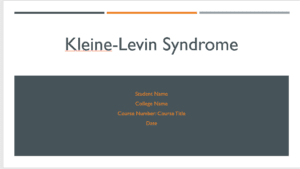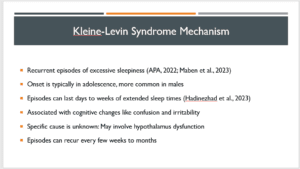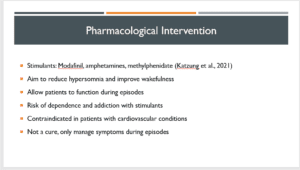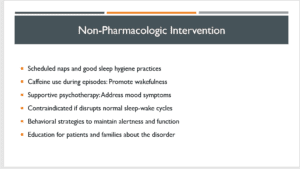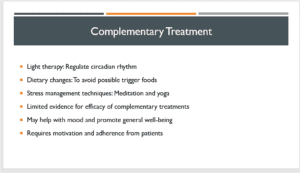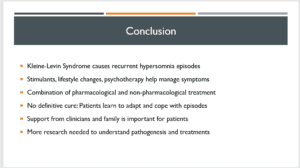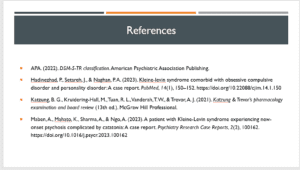Kleine-Levin Syndrome- Understanding the Disorder, Mechanisms, and Treatment Approaches
Welcome everyone. Today, I will be presenting on Kleine-Levin Syndrome, a rare sleep disorder that causes recurring episodes of excessive sleepiness. This presentation will cover the normal sleep cycle, the mechanism of Kleine-Levin Syndrome, pharmacological and non-pharmacological interventions, and complementary treatments. Please hold questions until the end.
Let’s first review the normal human sleep cycle. The average sleep cycle lasts 90-120 minutes and has distinct stages, including light sleep, deep sleep, and REM sleep. Most adults require 7-9 hours of sleep per 24-hour period for optimal functioning. The sleep-wake cycles are regulated by the circadian rhythm over 24 hours. Disruptions to this normal cycle from things like age, medications, health issues, or environment can lead to problems like insomnia, daytime fatigue, and impaired functioning.
Kleine-Levin Syndrome is characterized by recurrent episodes of excessive sleepiness lasting days to weeks. Onset typically occurs in adolescence and is more common in males (APA, 2022; Maben et al., 2023). During episodes, patients can sleep up to 20 hours per day and experience cognitive changes like confusion, irritability, and derealization. The exact cause is unknown but may involve dysfunction of the hypothalamus. Episodes can recur every few weeks to months, with normal cognition between episodes (Hadinezhad et al., 2023). This disorder significantly impacts patients’ functioning and quality of life.
To help manage hypersomnia and improve wakefulness during episodes, stimulants like modafinil, amphetamines, or methylphenidate may be used. These aim to reduce excessive sleeping and allow patients to function (Katzung et al., 2021). However, stimulants carry risks like dependence and addiction. They are contraindicated in those with cardiovascular conditions and do not represent a cure, only symptom management during episodes.
Non-drug interventions can also help manage Kleine-Levin Syndrome episodes. Scheduled naps and good sleep hygiene practices can improve wakefulness. Caffeine use promotes alertness during episodes. Also, supportive psychotherapy addresses associated mood symptoms. However, these strategies are contraindicated if they disrupt normal sleep-wake cycles. Behavioral modifications help maintain alertness and function. Patient and family education about the disorder is also important.
Some complementary treatments like light therapy, dietary changes, and stress management techniques may also provide some benefit. Light therapy aims to regulate the circadian rhythm. Dietary changes avoid possible trigger foods. Meditation, yoga, and massage help manage stress. However, there is limited evidence that these work for Kleine-Levin Syndrome, and they require patient motivation and adherence.
In conclusion, Kleine-Levin Syndrome is characterized by recurrent hypersomnia episodes that significantly impact patients’ lives. Treatment focuses on managing symptoms through stimulants, lifestyle changes, and psychotherapy. While there is no definitive cure, the combination of pharmacological and non-pharmacological interventions can help patients adapt and cope with episodes. Support from clinicians and family is crucial. More research is needed to better understand this disorder and its treatments.
Thank you.
ORDER A PLAGIARISM-FREE PAPER HERE
We’ll write everything from scratch
Question
For this Assignment, you will be creating a PowerPoint presentation on a sleep disorder from the DSM 5.
Slide 1: Title Slide
Slide 2: Normal sleep cycle
Slide 3: Underlying mechanism of chosen sleep disorder
Slide 4: Identify and describe a pharmacological intervention for treating chosen sleep disorder. Include the mechanism of action and any contraindications to this intervention.

Kleine-Levin Syndrome- Understanding the Disorder, Mechanisms, and Treatment Approaches
Slide 5: Describe a non-pharmacologic intervention for treating chosen sleep disorder. Include any contraindications or barriers to this intervention.
Slide 6: Choose a complementary or alternative treatment for addressing your chosen sleep disorder. Include any contraindications or barriers to this intervention.
Slide 7: Conclusion
Slide 8: References
Include a minimum of three references to support your ideas.

